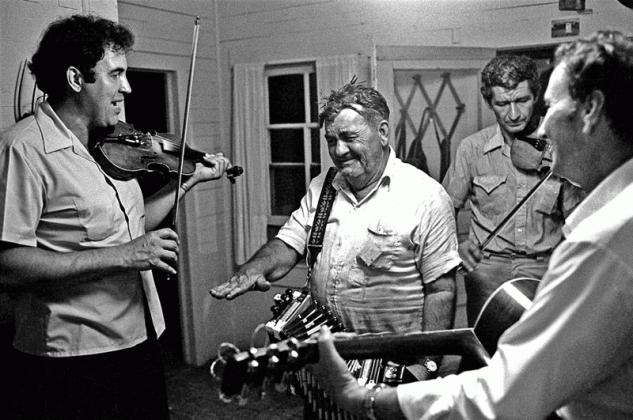
Darrel LeJeune / The Basile Weekly
In 1972, Ron and Fay Stanford came to southwest Louisiana to take up residence east of the Basile town limits at the homestead of the late Nonc Tom Young. Using Basile as their home base, the couple toured Acadiana, recording “French music” and shooting photos under a grant from the National Endowment for the Humanities.
As reported in an edition of The Basile Weekly last fall, the re-examination of the negatives taken back in 1970s led to the publishing of Big French Dance, featuring some of those old photos.
Since its release last September during an exhibit in Lafayette, the book has gained attention nationwide.
A recent issue of Humanities, the magazine for the National Endowment for the Humanities, featured the book as the edition’s cover story. The magazine is published quarterly in Washington, D.C. by the Smithsonian.
The eight page layout included 11 pictures plus the cover photo. Three of the featured pictures were taken in Basile and six locals were among the people pictured.
The Basile area residents pictured in the magazine are the late Dewey Balfa, the late Nathan Abshire, the late Canray Fontenot, Joe Boy Victorian, Christine Balfa, and an unidentified bar patron.
Local landmarks pictured in the magazine review include Nonc Tom’s home, which burned down a few years after the Stanfords were here, the Cajun Frontier Lounge, which was demolished to make room for Basile State Bank’s employee parking lot, and the Assumption Catholic Church Hall, which still stands but is no longer in use.
The book, itself, contains many more local images of people and places, most gone - but through this book, not forgotten.
The Humanities article said, “In the early seventies when young people sought relevance in all things, including the humanities, Nancy Moses, a graduate student, worked on a planning program for grants for younger scholars. These NEH grants went to filmmakers and researchers who were just getting a foothold, ‘younger than thirty-five,’ Moses remembers. ‘We wanted to train them as independent, entrepreneurial scholars.’ Ron and Fay Stanford, recent liberal arts graduates from Grinnell College in Iowa, received one of these grants. The following excerpts from Ron Stanford’s book Big French Dance tell the story of how the funds facilitated the work the Stanfords had begun on their own, photographing and recording Cajun and Creole musicians in Louisiana’s Bayou Country in 1972, at a time when the traditions and values of the rural populations of the French-speaking parishes were in jeopardy of vanishing.”
The magazine article includes the following forward from William R. Ferris:
“When they first heard performances of Cajun and zydeco music from south Louisiana, Ron Stanford and his future wife, Fay, were deeply moved by the experience. The suggestion, later, by Dewey Balfa, who had grown up surrounded by Cajun music and culture, that the Stanfords live in Louisiana someday was serendipitous. Balfa’s invitation gave the Stanfords an in, and his generosity, as Ron Stanford describes in the afterword to his photo album, Big French Dance, allowed Ron and Fay to live inexpensively in a home on a thousand-acre cattle and rice farm. The couple converted a smokehouse into a darkroom and, with help from an NEH grant, documented Cajun and zydeco music. The two years they spent photographing and interviewing musicians in their homes and in dance halls had an impact much later that neither the Stanfords nor the performers could imagine at the time. The music, recorded more than 45 years ago, can now serve as a time capsule, as can the photographs Ron Stanford rediscovered decades later. The Stanfords had seen and heard things strange and wonderful, and the images in the following photo essay capture their time in Louisiana in powerful, intimate ways that reveal how music defines black and white families in south Louisiana. They are also proof of the enduring power of NEH grants, which can transform the lives of both those who receive them and the communities celebrated by young people like Fay and Ron Stanford. This important partnership allowed the Stanfords to compile a landmark collection of photographs that beautifully captures the history of a people and their beloved music for future generations.”
Every Basile citizen (past and present) should own a copy of this book. For those who were alive in the early 1970s, the photos and stories will bring back fond memories of Basile’s bygone days. For those who are too young to remember or were not even born, the book will give you a small glimpse into the life of the community and surrounding towns some 50 years ago.
To order a copy of the book or copies of the black and white prints, themselves, go to bigfrenchdance.com.
